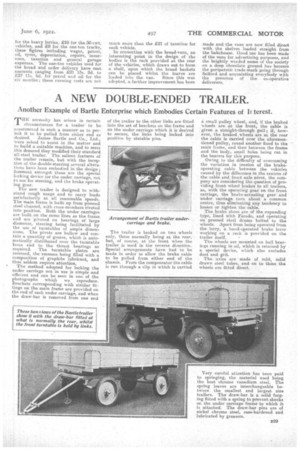A NEW DOUBLE-ENDED TRAILER.
Page 13

If you've noticed an error in this article please click here to report it so we can fix it.
Another Example of Bartle Enterprise which Embodies Certain Features of It terest.
TTIE necessity has arisen in certain circumstances for a trailer to be constructed in such a manner as to permit it to be pulled from either end as
desired. James Bartle and Co., Ltd., were asked to 'assist in the matter and to build a suitable machine, and to meet this demand they modified their standard all-steel trailer. The salient features of the trailer remain, but with the inception of the double-steering several alterations have been embodied in the design ; foremost amongst these are the special lceking device for the under carriage, not iq use for steering, and the brake operating gear.
The new trailer is designed to withstand rough usage and to carry lOads satisfactorily at all reasonable speeds. The main frame is built up from pressed steel channel, with cross-members riveted into position. Both the under carriages are built on the same lines as the. frame, and are pivoted on bearings of large diameter, steering being facilitated by the use of turntables of ample dimensions. The pivots are hollow and contain a quantity of grease, which is automatically distributed over the turntable faces and to the thrust bearings as required. The turntable plates are recessed, the recesses being filled with a composition of graphite lubricant, and thug seldom require attention.
The method adopted for locking the i under carriage not n use• is simple and efficient and can be seen in one of the photographs which we reproduce. Brackets corresponding with similar fittings on the main frame are provided on the end of each under carriage, and when the draw-bar is removed from one end of the trailer to the other links are fitted into the set of brackets on the frame and on the under carriage which it is desired to secure, the links being locked into position by siutable pins.
The trailer is braked on two wheels only, these normally ,being at the rear, but, of course, at the front when the trailer is used in the reverse direction. Special 'arrangements have had to be made in order to allow the brake cable to be pulled from either end of the chassis. From the compensator the cable is run through a clip in which is carried a small pulley wheel, and, if the braked wheels are at the front, the cable is given a straight-through pull; if, however, the braked wheels are at the rear the cable is -carried over the aforemeu tioned pulley, round another fixed to the main frame, and then between the frame and the body, small holes being cut in the bearers for this purpose.
Owing to the difficulty of overcoming the variation in tension of the brakeoperating cable between the vehicles caused by the difference in the centres of the cable and front axle pivot., the company are considering the question. of providing front wheel brakes to all trailers, as, with the operating gear on the front carriage, the brake-actuating gear and under carriage tons about a common centre, thus eliminating any tendency to loosen or tighten the cable.
The brake shoes are of the expanding type, lined with Ferodo, and operating on pressed steel drums bolted to the wheels. Apart from being operated from the lorry, a hand-operated brake lever working on a rack is provided on the trailer itself.
The wheels are mounted on ball bearings running in oil, which is retained by a special device, which also excludes dust and grit. The axles are made of cold, solid drawn steel tubes, and on to these the wheels are fitted direct.






























